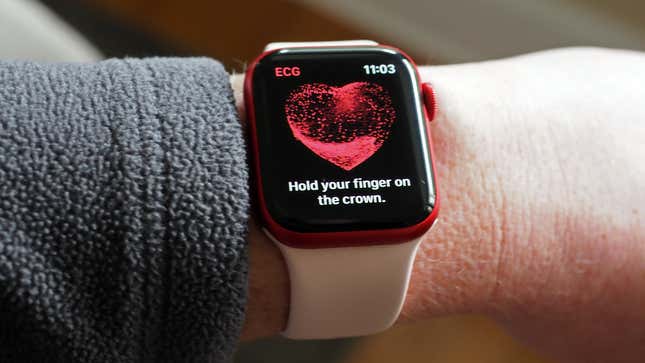
There’s no shortage of stories in which smartwatches have been credited with saving lives, but it turns out they can also predict the results of your blood tests, according to researchers from Duke University and Stanford University School of Medicine.
Thanks in part to machine learning, the researchers say that wearable data on heart rate, body temperature, and daily activity can be used to flag early signs of some conditions, as well as predict the results of clinical blood tests your doctor orders during annual physicals or other visits. The study, which was published in Nature Medicine, notes that smartwatches can help flag changes in your red blood cell count, dehydration, anemia, and even some illnesses.
Put simply, the goal of the study was to see how the long-term, continuous data collected by smartwatches stacked up against changes observed in in-person blood tests. To do this, the researchers tracked 54 patients for more than three years with an Intel Basis smartwatch that measured heart rate, step count, skin temperature, and electrodermal activity (the latter is the same metric that’s now tracked by the Fitbit Sense to measure minute electrical changes in your sweat.) Those participants also had regular clinical visits to collect data on heart rate, red and white blood cell count, blood oxygen levels, glucose levels, and other indicators via traditional means (i.e., heart rate monitors and blood tests).
The results indicated that certain combinations of wearable metrics could provide insight into specific blood tests. One instance was that researchers found that low electrodermal output, or less sweat, meant a patient was consistently dehydrated. They also found that sustained increases in body temperature, when paired with a decrease in movement, indicated illness—a result that was corroborated with higher white blood cell counts in blood tests. Changes in heart rate were also found to predict fluctuations in blood oxygenation. Meanwhile, lower activity when paired with a higher heart rate was also indicative of anemia.
However, the researchers also discovered there were limitations as well. While wearables can collect a plethora of data, much of it isn’t specific enough to precisely predict the number of red or white blood cells. Metrics like heart rate, body temperature, physical activity, and oxygen levels are also not sufficient enough to accurately diagnose which illness you might have.
Still, these are impressive results with some big implications. While more studies will have to be done, there’s the distinct potential that long-term wearable data could help doctors when determining treatment in emergency situations. Instead of having to wait for lab results in an ER, theoretically, a doctor could supplement that testing with your longitudinal data to try and determine what’s most likely going on. Right now, not many of us have that kind of data. The problem with current in-person clinical blood tests is that you have to, well, go get them in person, and that can be invasive. These tests also only provide a snapshot of your health—specifically, your health the day you went to see the doctor. Those results can be influenced by random things like when you last ate, or if someone stressed you out on the way to the doctor.
“There is a circadian (daily) variation in heart rate and body temperature, but these single measurements in clinics don’t capture that natural variation,” said Jessilyn Dunn, assistant professor of biomedical engineering at Duke, in a statement. “But devices like smartwatches or Fitbits have the ability to track these measurements and natural changes over a prolonged period of time and identify when there is variation from that natural baseline.”
This wearable advantage is one that scientists and researchers are well aware of. Many researchers during the pandemic launched studies to see if smartwatches could detect cases of covid-19. The results from those studies are still trickling in, but there’s reason to believe wearables might play a role in figuring out how to deal with future pandemics.
Technologically speaking, we’re also seeing companies like Apple, Samsung, and Fitbit delve into advanced health features beyond FDA-cleared ECGs and abnormal heart rate warnings. For instance, both Apple and Samsung have been rumored to be researching noninvasive ways to measure blood glucose levels for their next-gen smartwatches. Likewise, Fitbit’s made no attempt to hide that it’s been tinkering with a way to detect sleep apnea for years.
There are still major hurdles to clear before a future in which anyone can look at their wrist for a diagnosis. A lot more clinical research needs to be done, and advanced features will require at least FDA clearance before they can be used by the public. Plus, medical professionals are still figuring out what to do if and when a patient shows up to an appointment and simply hands them a PDF of random data. And, to be clear, wearables will never replace the need for doctors and other medical professionals. Even so, research like this is incredibly promising.
“I think this is just the beginning,” study co-author Michael Snyder, chair and professor of genetics at Stanford University of Medicine, said in a press release. “Devices are becoming much more sensitive and with many more capabilities. As the technology continues to advance, people will be better equipped to understand what’s going on with their own health in real time, just through their wearable devices.”